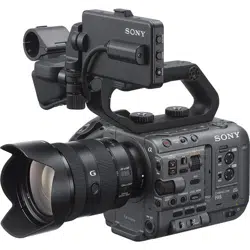Loading ...
Loading ...
Loading ...

3. Shooting
52
Shooting with the Desired Look
When the camcorder is in Custom mode, you
can add adjustments to the black, matrix, and
other parameters to create a “look” based on
the base look.
:
Look
Matrix
Black
Base look
You can also quickly select a different look by
saving different combinations of settings in
scene files.
The camcorder is provided with a total of six
preset looks.
Selecting a Look
1 With the shooting screen displayed, press
the multi-function dial.
2 Select the SCN icon.
3 Press the multi-function dial.
4 Select the desired look from the menu,
and press the multi-function dial.
[Tips]
The following presets are configured by factory
default.
Shooting Mode Custom
Target Display SDR(BT.709) HDR(HLG)
Scene file 1 S-Cinetone HLG Live
Scene file 2 Standard HLG Natural
Scene file 3 Still (Not
registered)
Scene file 4 ITU709 (Not
registered)
Scene files
5 to 16
(Not
registered)
(Not
registered)
You can also select a look using Scene File
(page 13) on the Main Status screen or Scene File
>Recall (page 83) in the Paint/Look menu of the
full menu. You can also recall a preset look using
Scene File >Preset Recall.
Importing a Desired Base Look
You can import a 3D LUT file, created on a
computer or other device, as a base look. Up
to 16 files can be imported.
File format: CUBE file (*.cube) for a 17-point
or 33-point 3D LUT created using Catalyst
Browse, RAW Viewer, or DaVinci Resolve*
(by Blackmagic Design Pty. Ltd.).
* Verified with Resolve V9.0, V10.0, and V11.0.
Input color space/Gamma: S-Gamut3.
Cine/S-Log3 or S-Gamut3/S-Log3
1 On the computer or other device, save the
3D LUT file in the specified folder or the
recording media.
Recording
media
Folder path
SDXC /PRIVATE/SONY/PRO/LUT/
CFexpress
Type A
/SONY/PRO/LUT/
2 Insert the recording media on which 3D
LUT files are saved into CFexpress Type
Type A/SD card slot (B).
3 Select Base Look >Import (page 83) in
the Paint/Look menu of the full menu.
4 Select an import destination.
5 Select a 3D LUT file to import.
Follow the on-screen instructions. The
camcorder handles a 3D LUT file as a base
look.
6 Select the imported 3D LUT file using Base
Look >Select (page 83) in the Paint/
Look menu of the full menu.
7 Configure Base Look >Input and Output
(page 83) in the Paint/Look menu of
the full menu to match the attributes of
the imported 3D LUT file.
Adjusting for underexposure
If there is a tendency for underexposure when
auto exposure is selected when using the
imported basic look, adjust Base Look >AE
Level Offset (page 83) in the Paint/Look
menu.
[Notes]
Just importing a 3D LUT file does not affect the
image. Load the imported 3D LUT file using Base Look
>Select (page 83) in the Paint/Look menu of the
full menu.
If Input is not set correctly, the proper look will not be
obtained.
The Input, Output, and AE Level Offset menu item
settings are applied to the base look selected using
Select. If multiple 3D LUT files are imported, select
Select for each 3D LUT file, and configure Input,
Output, and AE Level Offset individually for each file.
The configured Input, Output, and AE Level Offset
settings are saved for each 3D LUT file.
The base look/LUT selection options for imported 3D
LUT files are common to SDR(BT.709)/HDR(HLG)/Cine
EI modes, but color space and gamma conversion is
not performed according to these modes.
3D LUT files are not deleted when All Reset >Reset is
selected in the Maintenance menu.
Loading ...
Loading ...
Loading ...
